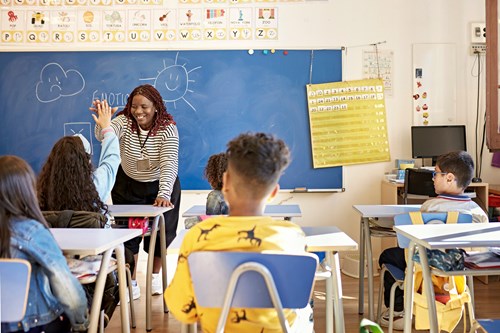Pronunciation: what we think and what we do
What is pronunciation instruction and how do teachers do it? What ways can pronunciation be taught? Chiara Bruzzano takes a look at common methods and what the research says about teachers’ beliefs and practices, as well as the impact of teacher education.

Whenever I think about teaching pronunciation, my mind goes back to one of my most treasured memories as a teacher: me, in a meeting room turned classroom, with a handful of my business consultant students, all dressed very seriously in their suits… playing ‘pronunciation snap’. I made a few decks of cards with words containing sounds that we had studied; in pairs, the students took turns turning the cards over and if they thought they contained the same sound, they shouted ‘Snap!’ and won the cards. The cherry on top was that the words were mostly business-related, so they were shouting and having fun to the tune of ‘business’ and ‘bankruptcy’ both having the short ɪ sound.

I will be honest here: I was doing this mostly because it was fun, so I won’t claim I had thought much about it in pedagogical terms. It is also the case that students valued pronunciation as a priority, so it felt like I was tackling one of the areas we identified in their Needs Analysis. But in the years that followed, I often wondered: did this sort of activity serve any purpose at all (other than letting their hair down after a 12-hour workday)?
Pronunciation: a neglected area?
I have lost count now of all the articles, presentations and videos I’ve seen that claim that X is a neglected area in language teaching. However, come to think of it, I do agree with Robin Walker in his article, ‘Pronunciation matters’ that pronunciation is often done on an ad hoc basis and not programmed in the same way that vocabulary or grammar might be. In other words, explicit pronunciation activities like my snap game are more infrequent occurrences.
On the one hand, this definitely reflects my experience as a teacher and as an observer in other teachers’ classes: pronunciation is sometimes an afterthought and it is dealt with on an emergent basis. On the other hand, I think we should also give working with emergent language the credit it deserves: as Jonathan Marks reminds us in ‘A pronunciation answer key’, pronunciation instruction might arise from ongoing classroom discourse and, as we know from SLA research, dealing with this kind of emergent language responds to the learner’s internal syllabus, pushing them to develop linguistically.

Teaching pronunciation: how do teachers do it?
In her research on teachers’ cognitions and knowledge about pronunciation instruction, Baker (2014) observed twenty lessons and categories pronunciation instruction techniques into three broad categories: controlled activities (e.g. listening to a text, repetition drills), guided activities (e.g. in pairs, student A produces a target form and student B gives feedback if need be) and free activities, such as games, drama or presentations.
In Baker’s observations, the most frequently used techniques overall were by far the controlled ones. As Baker (2014: 153) explains, this dominance of controlled activities to the detriment of guided and free techniques raises concerns because the ‘use of communicative activities involving dyadic interaction has the potential for greater impact on learner uptake and automatic use of targeted features of pronunciation than focus-on-form instruction alone’.
Interestingly, the three teachers that had attended a course specifically on pronunciation instruction were the ones that used the widest repertoires of techniques, suggesting that teacher education can have an impact on pronunciation teaching. Nevertheless, when they investigated teachers’ practices over a six-year span, Burri and Baker (2021) found that even if they had attended courses on pronunciation instruction, these teachers’ practices eventually reverted to teacher-centred techniques. The effect of teacher education on teachers’ practices in the long term is, of course, a long-standing dilemma in the field, but to me, this study suggests that teachers should be encouraged to make pronunciation part of a continuous cycle of reflective practice. Richard Chinn has some interesting and relevant guidance on this in his article ‘Working with emergent language’.
What do teachers think?
When reflecting on any part of our practice as teachers, our beliefs are an important starting point: as research shows, teachers’ beliefs can be deeply ingrained and be far more influential on teaching practices than teacher education programmes. In my case, for example, I must admit that I have an inbuilt bias on pronunciation: as I have discussed in a previous post, I have a longstanding issue with passing for a native speaker and I know pronunciation and accents are often conflated by students. Reflecting on this led me to introduce a discussion early on my courses (often at the Needs Analysis stage) about the difference between the two and how to go about establishing realistic and useful pronunciation goals.
In her research, Baker (2014) found that the teachers she worked with held three key beliefs:
- Listening perception is essential for producing comprehensible speech
- Kinaesthetic/tactile practice is integral to phonological improvement
- Pronunciation instruction can be boring
Think about these three statements for a moment: do you agree? Or disagree? Do they reflect your experience? I took the doing of taking a little Twitter poll: the sample size was small – so it’s a little as if I had asked the question in a teachers’ lounge – but as it turned out, there was general agreement on numbers 1 and 3, while my respondents mostly disagreed with statement 2.

If we are reflecting on our beliefs as part of our reflective practice, it may be useful to know what the research says about them. For example, the first belief appears to be widely supported by research, which shows that there is a link between listening training and accurate phonetic production and that these improvements are maintained in the long term (Bradlow, Akahane-Yamada, Pisoni, & Tohkura, 1999).
So how can we go about teaching pronunciation?
After reflecting on our beliefs on pronunciation, we may want to challenge them and possibly try out some new techniques and materials. Here are some useful references to do this:
- ‘In praise of pronunciation’ by Jonathan Marks: read this article to reconsider your thoughts on pronunciation and its implications for language learning broadly speaking.
- ‘Pronunciation matters’ by Robin Walker: this article will help you discover the effects of pronunciation not just on speaking, but on the other three skills too.
- ‘Pronunciation games' by Jason Anderson: find out some fun games to programme some pronunciation instruction into your teaching (including my beloved Snap!)
- ‘Technology for pronunciation’ by Robin Walker: discover how we learn to pronounce and what technology can do to support our pronunciation instruction.
- IATEFL PronSIG: if you find that you are really into pronunciation, what better place to find out more and network with like-minded teachers than the pronunciation special interest group (SIG) of IATEFL, where you’ll find articles, videos and a series of interesting free* events to attend! (*Subject to you having an IATEFL membership and joining this SIG)
- ETpedia Pronunciation by John Hughes and Gerhard Erasmus, due out this Autumn, published by Pavilion Publishing and Media. With 500 ideas on pronunciation teaching and activities, it could be a gold mine for freer practice activities and a lot more besides.
So, what is your take on pronunciation? Is instruction helpful and if so, what are your favourite activities? Let me know in the comments!
References
Baker, A. (2014). ‘Exploring Teachers' Knowledge of Second Language Pronunciation Techniques: Teacher Cognitions, Observed Classroom Practices, and Student Perceptions’. TESOL Quarterly, 48 1:136–163. Hoboken, New Jersey: Wiley-Blackwell on behalf of TESOL International Association. doi:10.1002/tesq.99
Bradlow, A. R., Akahane-Yamada, R., Pisoni, D. B., & Tohkura, Y. i. (1999). ‘Training Japanese listeners to identify English/r/and/l: Long-term retention of learning in perception and production’. Perception and Psychophysics, 61 5:977–985. Chicago, Illinois: Psychonomic Society.
Burri, M., & Baker, A. (2021). ‘“I Feel … Slightly out of Touch”: a Longitudinal Study of Teachers Learning to Teach English Pronunciation over a Six-Year Period’. Applied Linguistics, 42 4:791–809. Oxford: Oxford Academic. doi:10.1093/applin/amab009

Comments
Write a Comment
Comment Submitted